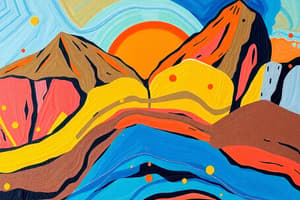Podcast
Questions and Answers
What is the rock cycle?
What is the rock cycle?
- The process of rocks changing into other rocks due to weathering and erosion
- The process of rocks changing into other rocks due to plate tectonics and the water cycle (correct)
- The process of rocks changing into other rocks due to volcanic eruptions
- The process of rocks changing into other rocks due to meteor impacts
What are the three types of rocks involved in the rock cycle?
What are the three types of rocks involved in the rock cycle?
- Igneous, metamorphic, and sedimentary (correct)
- Igneous, metamorphic, and volcanic
- Metamorphic, sedimentary, and volcanic
- Igneous, sedimentary, and volcanic
What can happen to rocks at low temperatures and pressures?
What can happen to rocks at low temperatures and pressures?
- They can undergo secondary changes such as silicification and serpentinization (correct)
- They can melt into magma
- They can turn into metamorphic rocks
- They can turn into sedimentary rocks
What can happen to rocks exposed to high temperatures and pressures?
What can happen to rocks exposed to high temperatures and pressures?
What drives the rock cycle?
What drives the rock cycle?
What role does water play in the rock cycle?
What role does water play in the rock cycle?
What is magma?
What is magma?
What are the two types of igneous rocks?
What are the two types of igneous rocks?
What is lithification?
What is lithification?
Flashcards
What is the rock cycle?
What is the rock cycle?
The constant process of rocks transforming into other types of rocks due to the forces of plate tectonics and the water cycle.
What are the three main rock types?
What are the three main rock types?
Igneous, metamorphic, and sedimentary rocks. These rock types are constantly changing and interacting within the rock cycle.
What are igneous rocks?
What are igneous rocks?
Igneous rocks originate from the cooling and solidification of magma or lava.
What is the difference between magma and lava?
What is the difference between magma and lava?
Signup and view all the flashcards
What are sedimentary rocks?
What are sedimentary rocks?
Signup and view all the flashcards
What are metamorphic rocks?
What are metamorphic rocks?
Signup and view all the flashcards
What forces drive the rock cycle?
What forces drive the rock cycle?
Signup and view all the flashcards
What is the role of water in the rock cycle?
What is the role of water in the rock cycle?
Signup and view all the flashcards
What is Lithification?
What is Lithification?
Signup and view all the flashcards
Study Notes
The rock cycle describes the transitions between sedimentary, metamorphic, and igneous rock types due to plate tectonics and the water cycle. Rocks can melt into magma and solidify into igneous rocks, which can be intrusive or volcanic. Secondary changes such as silicification and serpentinization can occur at low temperatures and pressures. Rocks exposed to high temperatures and pressures can turn into metamorphic rocks, either by regional metamorphism or contact metamorphism. Rocks exposed to weathering and erosion can turn into sedimentary rocks, either by lithification of clastic material, biogenic material, or chemically precipitated material. Plate tectonics, spreading ridges, subduction zones, and continental collisions drive the rock cycle. Water plays an important role in weathering, erosion, and metamorphism processes. The rock cycle is an evolutionary process that involves magma generation and segregation within or between the mantle and crust.
Studying That Suits You
Use AI to generate personalized quizzes and flashcards to suit your learning preferences.


